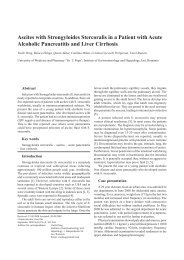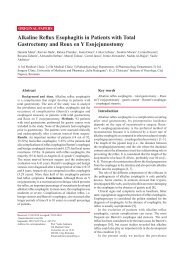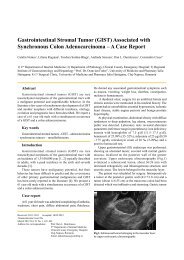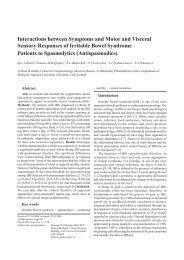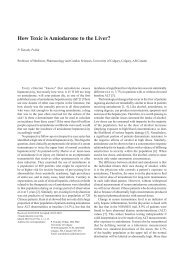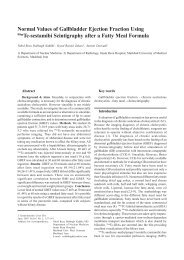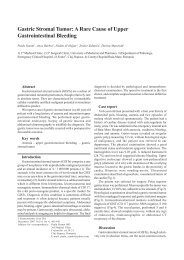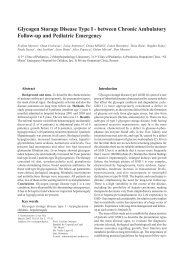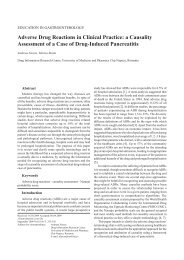Management of Boerhaave's Syndrome: Report of Three ... - rjge.ro
Management of Boerhaave's Syndrome: Report of Three ... - rjge.ro
Management of Boerhaave's Syndrome: Report of Three ... - rjge.ro
Create successful ePaper yourself
Turn your PDF publications into a flip-book with our unique Google optimized e-Paper software.
Boerhaave’s synd<strong>ro</strong>me 83<br />
Fig.1 Patient 1.Upright plain x-ray (a), esophagogram (b), and<br />
contrast enhanced CT scan (c) revealing a right sided, distal<br />
esophageal rupture, with ipsilateral hyd<strong>ro</strong>pneumothorax and<br />
pleural empyema.<br />
a bleeding vessel in the duodenal ulceration, pylo<strong>ro</strong>plasty,<br />
draining gast<strong>ro</strong>stomy and feeding jejunostomy were<br />
fashioned via an upper midline lapa<strong>ro</strong>tomy. Additionally, a<br />
right thoracotomy for better drainage and lavage <st<strong>ro</strong>ng>of</st<strong>ro</strong>ng> the right<br />
thoracic cavity was performed and the chest was closed with<br />
two large thoracostomy tubes in situ. A hypaque swallow<br />
study, on the 4th postoperative week demonstrated closure<br />
<st<strong>ro</strong>ng>of</st<strong>ro</strong>ng> the esophageal rent but revealed the development <st<strong>ro</strong>ng>of</st<strong>ro</strong>ng> a<br />
stricture along the lower third <st<strong>ro</strong>ng>of</st<strong>ro</strong>ng> the esophagus, which p<strong>ro</strong>ved<br />
to be refractory to multiple endoscopic dilatations performed<br />
between the 9th and 11th postoperative weeks. The patient<br />
was considered to be unfit for esophageal replacement and in<br />
addition he was reluctant to undergo any major intervention.<br />
Hence, a covered self-expanding metallic stent (Ultraflex,<br />
Boston Scientific) was inserted on the 12th postoperative<br />
week, endoscopically. During the follow-up period he was<br />
able to eat normally and maintain his weight. He survived<br />
for 3 years and finally died <st<strong>ro</strong>ng>of</st<strong>ro</strong>ng> a severe depression disorder.<br />
Patient 2<br />
A 32-year-old man, with no history <st<strong>ro</strong>ng>of</st<strong>ro</strong>ng> previous illness<br />
but with an ambiguous reference to recent food and drink<br />
overindulgence, was presented to a peripheral Hospital<br />
Emergency department complaining <st<strong>ro</strong>ng>of</st<strong>ro</strong>ng> the sudden onset<br />
<st<strong>ro</strong>ng>of</st<strong>ro</strong>ng> gradually increasing, lower thorax post emetic pain and<br />
subcutaneous emphysema. The suspicion <st<strong>ro</strong>ng>of</st<strong>ro</strong>ng> spontaneous<br />
esophageal rupture was confirmed on a subsequent erect<br />
x-ray film, CT scan and esophagogram by the presentation<br />
<st<strong>ro</strong>ng>of</st<strong>ro</strong>ng> bilateral pleural effusion together with left sided contrast<br />
extravasation f<strong>ro</strong>m the lower third <st<strong>ro</strong>ng>of</st<strong>ro</strong>ng> the esophagus (Fig.2).<br />
Fig.2 Patient 2. Esophagogram depicting a leftsided<br />
leak.<br />
Bilateral thoracotomies, closure <st<strong>ro</strong>ng>of</st<strong>ro</strong>ng> the esophageal<br />
perforation in two layers, buttress <st<strong>ro</strong>ng>of</st<strong>ro</strong>ng> the defect with viable<br />
regional pleural flap and placement <st<strong>ro</strong>ng>of</st<strong>ro</strong>ng> chest tubes were<br />
performed. Subsequently, the patient was transferred to<br />
our department because <st<strong>ro</strong>ng>of</st<strong>ro</strong>ng> lack <st<strong>ro</strong>ng>of</st<strong>ro</strong>ng> ICU. On postoperative<br />
day 8, the patient demonstrated clinical signs <st<strong>ro</strong>ng>of</st<strong>ro</strong>ng> a recurrent<br />
leak, with recrudescing systemic sepsis, dyspnea, and<br />
hemodynamic instability. The subsequent CT scan study<br />
demonstrated contrast medium extravasation accompanied<br />
with large pleural effusion bilaterally. Re-operation was<br />
considered inevitable, during which mediastinum and pleural<br />
debridement, forcible irrigation <st<strong>ro</strong>ng>of</st<strong>ro</strong>ng> pleural spaces, cervical<br />
esophagostomy in combination with closure <st<strong>ro</strong>ng>of</st<strong>ro</strong>ng> the distal<br />
esophagus, feeding jejunostomy and draining gast<strong>ro</strong>stomy,<br />
were performed. Postoperatively, thoracotomies were left<br />
opened and continuous irrigation systems were applied to our<br />
patient’s thoracic wounds [6]. The patient had a p<strong>ro</strong>longed<br />
ICU stay, mainly because <st<strong>ro</strong>ng>of</st<strong>ro</strong>ng> the need for ventilation, as a<br />
result <st<strong>ro</strong>ng>of</st<strong>ro</strong>ng> severe pneumonitis, along with relapsing incidences<br />
<st<strong>ro</strong>ng>of</st<strong>ro</strong>ng> systemic sepsis. Eventually, he was returned to the main<br />
ward on the 5th postoperative week. After a total period <st<strong>ro</strong>ng>of</st<strong>ro</strong>ng><br />
14 weeks, the patient was discharged, continuing total enteral<br />
alimentation. Five months later, he underwent reconstruction<br />
by joining the cervical esophagus to the stomach using<br />
ret<strong>ro</strong>sternal left colic flexure based on the left branch <st<strong>ro</strong>ng>of</st<strong>ro</strong>ng> the<br />
middle colic vessels. He can now eat normally and maintain<br />
his weight and is leading a normal existence.<br />
Patient 3<br />
A 47-year-old man, with no history <st<strong>ro</strong>ng>of</st<strong>ro</strong>ng> previous illness,<br />
and with reference to a preceding overindulgence in a<br />
large meal, presented to our Department, complaining <st<strong>ro</strong>ng>of</st<strong>ro</strong>ng>




